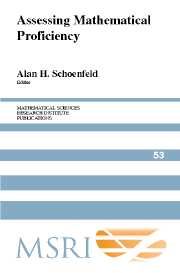Book contents
- Frontmatter
- Contents
- Preface
- Acknowledgments
- Section 1 The Big Picture
- Section 2 Perspectives on Mathematical Proficiency
- Section 3 What Does Assessment Assess? Issues and Examples
- Section 4 The Case of Algebra
- Section 5 What Do Assessments Assess? The Case of Fractions
- Section 6 The Importance of Societal Context
- Epilogue What Do We Need to Know? Items for a Research Agenda
- About the Authors
- Subject Index
- Author Index
- Task Index
Chapter 13 - Task Context and Assessment
Published online by Cambridge University Press: 06 July 2010
- Frontmatter
- Contents
- Preface
- Acknowledgments
- Section 1 The Big Picture
- Section 2 Perspectives on Mathematical Proficiency
- Section 3 What Does Assessment Assess? Issues and Examples
- Section 4 The Case of Algebra
- Section 5 What Do Assessments Assess? The Case of Fractions
- Section 6 The Importance of Societal Context
- Epilogue What Do We Need to Know? Items for a Research Agenda
- About the Authors
- Subject Index
- Author Index
- Task Index
Summary
In this chapter, I will explore the impact of task context on assessment in mathematics. It is nontrivial to determine the understandings measured by a given assessment, so a close examination of some tasks and what they reveal is the main focus of this paper. Before considering these contemporary explorations, and in order to establish for the reader that the context of a mathematics task is indeed a salient feature, I will review findings from research in mathematics education and psychology. I will show that the role of context in mathematics assessment is a complex issue that involves much more than capturing the interest and harnessing the motivation of the student.
Keeping it real. Over the past several decades, many different researchers and educators have pointed out the benefits of setting mathematical tasks in rich, attractive, and realistic contexts (e.g., [de Lange 1987; Freudenthal 1983]). Realistic contexts are generally regarded as referring to aspects of the “real” social or physical world as well to fictional, imaginary, or fairy-tale worlds. Specifically, there are no restrictions on the contexts that can be called realistic as long as they are meaningful, familiar, appealing, and morally appropriate for students. In the literal sense, it is not the degree of realism that is crucial for considering a context as realistic, but rather the extent to which it succeeds in getting students involved in the problem and engages them in meaningful thinking and interaction.
Realistic contexts are recommended for two main reasons. On the one hand, it is thought that a realistic context will facilitate student success by intrinsically motivating students and thus increasing the likelihood that they will make a serious effort to complete the problem. On the other hand, a realistic context may facilitate performance by helping students to make a correct representation of the problem and to formulate and implement a feasible solution strategy by activating the use of prior knowledge specific to that context that is helpful for understanding and solving the problem.
There is growing evidence, however, that realistic contexts can have a negative impact on the performance of students on mathematics tasks. For example, [Boaler 1994] analyzed the performance of 50 students from a school with a traditional approach to mathematics education on two sets of three questions intended to assess the same content, but set in different contexts. Interestingly, the girls from the school that Boaler studied tended to attain lower grades on an item that had been cast in the context of “fashion” than they did on isomorphic items that were cast either in an abstract context or even in a realistic context that was thought to be inherently less appealing to the girls (such as football— “soccer” in U.S. terms). According to Boaler, the girls’ relatively poor performance on the fashion item was caused by the problem context distracting them from its deeper mathematical structure.
Information
- Type
- Chapter
- Information
- Assessing Mathematical Proficiency , pp. 177 - 192Publisher: Cambridge University PressPrint publication year: 2007
Accessibility standard: Unknown
Why this information is here
This section outlines the accessibility features of this content - including support for screen readers, full keyboard navigation and high-contrast display options. This may not be relevant for you.Accessibility Information
- 2
- Cited by
